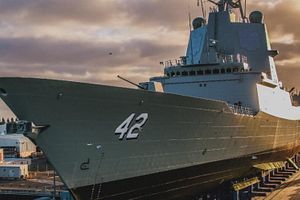The Royal Australian Navy’s (RAN) third air warfare destroyer, the future HMAS Sydney (DDG 42), was launched during a ceremony at Osborne Naval Shipyard in Adelaide in South Australia on May 19, the service said in a statement.
The Sydney will be the third and final ship of the 7,000-ton Hobart-class of guided-missile (air warfare) destroyers to join the RAN. The warship, based on the Navantia-designed Álvaro de Bazán-class frigate (aka F-100) currently in service with the Spanish Navy, was laid down in November 2015. The ship will continue fitting out prior to the beginning of sea trials in 2019. The Sydney is expected to be delivered to the RAN in March 2020.
“In the last three years we have seen the launch of the first two Air Warfare Destroyers – HMAS Hobart and NUSHIP Brisbane – and with the launch today of Sydney, the class is now complete,” the Chief of Navy Vice Admiral Tim Barrett said during the launch ceremony. “They are powerful, elegant new warships that will serve Australia as a key part of our fleet for decades to come – a fleet that will be strong, agile, intelligent, and lethal.” Hobart-class guided-missile destroyers are multi-purpose warships that can be used for anti-surface and anti-submarine warfare operations, as well as escort and land attack missions.
“The Hobart class destroyers not only deliver revolutionary air defense capabilities against advanced aircraft and cruise missile threats, but these formidable warships are also providing the Navy with unsurpassed anti-submarine warfare capabilities. Sydney, together with her sister ships, HMAS Hobart and Brisbane, are true examples of Australian defense industry capability – designed for Australia and built by Australians,” Navantia Australia’s Chairman Warren King said in a statement published by the Air Warfare Destroyer (AWD) Alliance, the consortium responsible for building and delivering the new destroyer class.
The AWD Alliance consortium coordinates the work of Spanish ship maker Navantia, the Australian shipbuilder ASC, mission systems integrator Raytheon Australia, U.S. defense contractor Lockheed Martin, and the Australian Department of Defense. The Hobart-class is the first class of Australian warships to be built around the U.S.-made Aegis combat system. The Hobart-class is fitted with one of most technologically advanced phased-array radar systems currently available, the AN/SPY-1, which is paired with the ship’s main weapon, the 48-cell MK 41 Vertical Launching System, capable of firing Raytheon’s Standard Missiles (SM) of all variants as well as the RIM-162 Evolved Sea Sparrow Missile.
The ships are also fitted with a modern sonar system and are additionally armed with surface-launched torpedoes as well as Harpoon anti-ship missiles. All three ships will also operate the so-called cooperative engagement capability (CEC), a new wide-area integrated air defense system. Originally, the Hobart-class was to be operational by June 2017. However, the program was plagued by multiple problems and delays right from the start, as I wrote in 2017:
The Hobart-class program suffered from repeated delays since its inception. One of the consequences of the multiple delays has been that the Hobart-class’ Aegis combat system (…) purchased by the Australian Department of Defense is purportedly outdated and will likely need to be expensively upgraded, given that the U.S. Navy already developed a more advanced version of Aegis. (…)
Total procurement costs are estimated at over $8 billion, making this Australia’s most expensive weapons program to date. Approximately half of that amount has been earmarked for major upgrades following the ships’ commissioning.
The first-of-class air warfare destroyer HMAS Hobart conducted its first-ever replenishment at sea in February. The ship also held other first-of-class trials including launching test torpedoes, anti-air gunnery trials, and firing the ship’s close in weapon system this year.
































